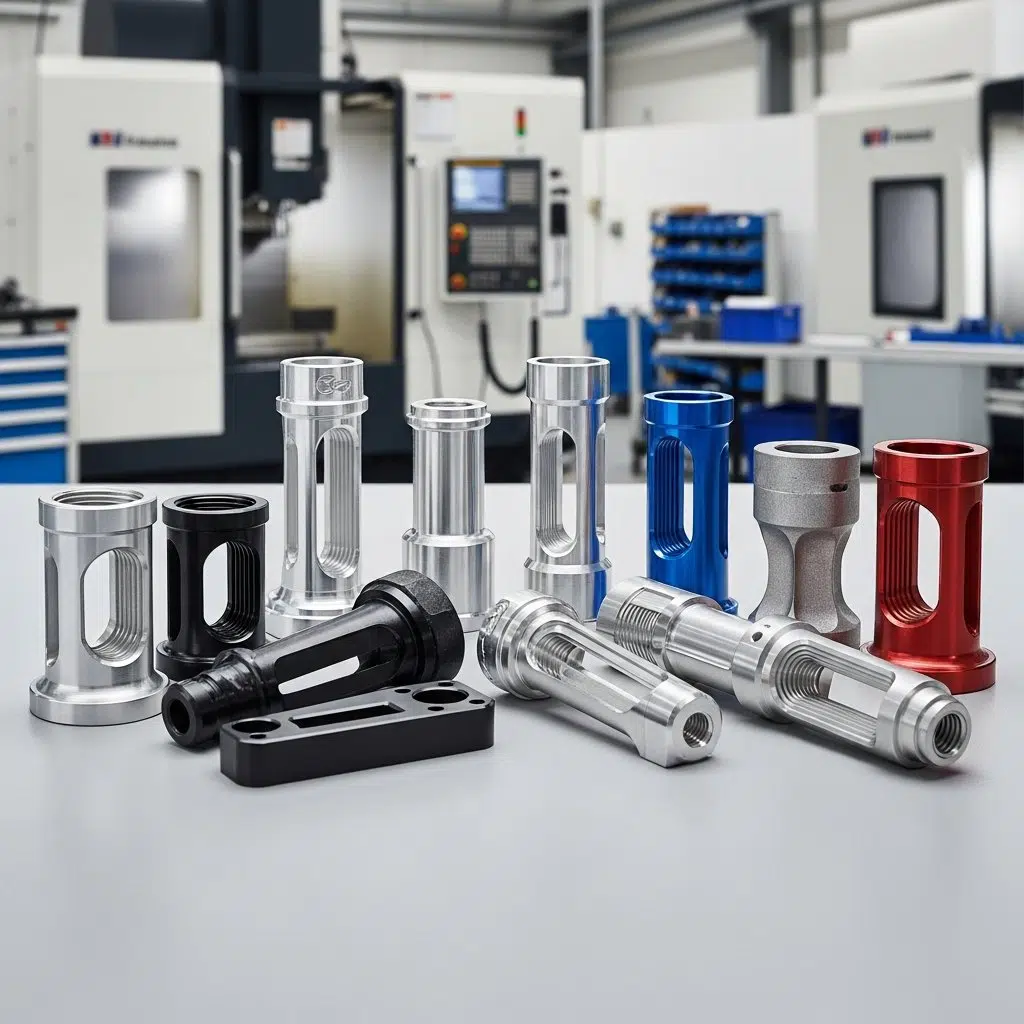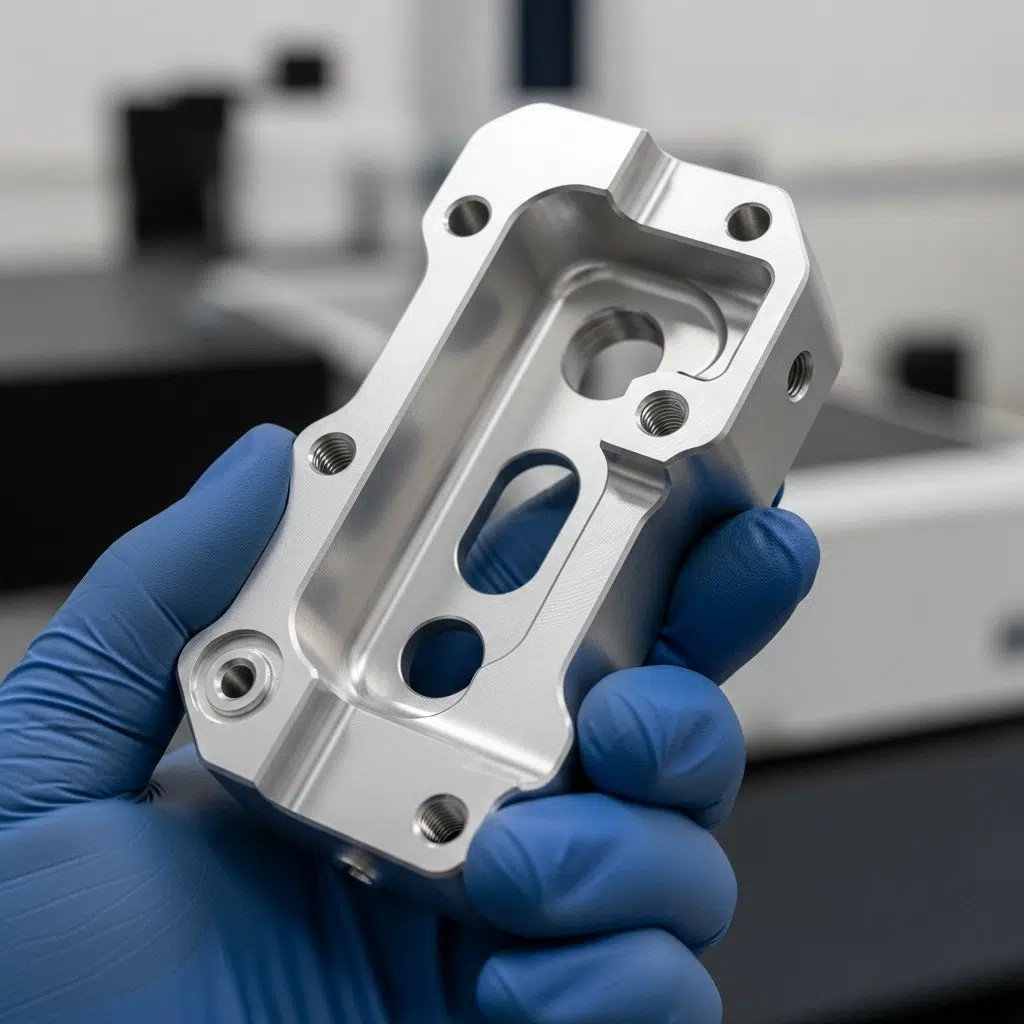Micro-Arc Oxidation (MAO) is an advanced electrochemical surface treatment process that creates hard, dense, ceramic-like oxide layers on light alloys such as aluminum, magnesium, and titanium. Unlike conventional anodizing, MAO produces thicker, more amorphous, and often multi-functional composite films with superior properties. Its key benefits for CNC machined components include significantly enhanced corrosion and wear resistance, excellent dielectric and thermal insulation, and the capability to achieve biocompatible and food-grade oxidation, making it indispensable for high-performance applications in aerospace, medical, and food processing industries.
Article Introduction
- PAS Introduction: Overcoming CNC Machining Surface Challenges
- Understanding Micro-Arc Oxidation (MAO) for CNC Machined Parts
- The Multifunctional Nature of MAO Coatings on Precision Components
- Enhancing CNC Machined Components with MAO’s Core Functions
- Advantages of Micro-Arc Oxidation for CNC Manufacturing
- Addressing Limitations: Disadvantages of MAO in CNC Machining Projects
- Key Application Areas for Micro-Arc Oxidation in Modern Industry
PAS Introduction: Overcoming CNC Machining Surface Challenges
In the intricate world of modern manufacturing, particularly within CNC machining, we frequently encounter a persistent challenge: achieving surface properties that meet the increasingly stringent demands for durability, performance, and safety. Traditional surface treatments often fall short, struggling to deliver the robust corrosion resistance, superior wear properties, or critical biocompatibility required for advanced applications.
This inadequacy can lead to significant pain points for our clients, ranging from premature component failure and costly maintenance to non-compliance with vital industry standards, especially in sectors requiring food-grade oxidation. Such limitations directly impact product lifespan, operational efficiency, and market acceptance.
At ly-machining in Shenzhen, we recognize these critical issues. Our solution often involves the application of Micro-Arc Oxidation (MAO) – an advanced surface treatment that transforms the limitations of conventional coatings. MAO provides a pathway to create integrated, multi-functional composite films that not only overcome these challenges but also elevate the performance of CNC machined components to new industry benchmarks.
Understanding Micro-Arc Oxidation (MAO) for CNC Machined Parts
Micro-Arc Oxidation, often referred to as Plasma Electrolytic Oxidation (PEO), is an electrochemical surface treatment that generates dense, hard, ceramic-like oxide layers on light metals. We typically apply this process to alloys of aluminum, magnesium, and titanium, which are frequently used in precision CNC machining.
Unlike conventional anodizing, MAO involves applying high voltages in an aqueous electrolyte, leading to micro-discharges on the metal surface. These discharges melt and react with the substrate, forming a significantly thicker, more amorphous, and highly adherent ceramic coating. This distinct process provides a superior protective layer for various CNC machined components.

Our experience confirms that these coatings are not merely superficial; they represent a fundamental transformation of the surface, crucial for the longevity of many CNC machining applications.
| Feature | Micro-Arc Oxidation (MAO) for CNC Components | Conventional Anodizing for CNC Components |
|---|---|---|
| Coating Thickness | 10-200 µm, significantly thicker ceramic layer | 5-25 µm, thinner porous layer |
| Hardness (HV) | 400-2000 HV, ceramic-like | 200-500 HV |
| Adhesion | Excellent, metallurgical bond | Good, electrochemical bond |
| Corrosion Resistance | Superior, dense, sealed layer | Good, requires sealing |
| Wear Resistance | Excellent | Moderate |
| Dielectric Strength | High | Moderate |
| Material Scope | Al, Mg, Ti alloys (common in cnc machining) | Primarily Al alloys |
| Process | High voltage, micro-discharges, plasma formation | Lower voltage, electrolytic oxidation |
The Multifunctional Nature of MAO Coatings on Precision Components
One of the most compelling aspects of Micro-Arc Oxidation, especially for us in Shenzhen working with diverse industrial needs, is its ability to create multifunctional composite films. This process allows for the integration of various properties into a single, cohesive coating.
During the MAO process, elements from the electrolyte can be incorporated into the growing oxide layer, leading to tailored functionalities. This capability ensures that the resulting coating on CNC machined parts can concurrently offer enhanced corrosion resistance, superior wear protection, and specific characteristics like biocompatibility or even food-grade oxidation. We often leverage this for complex projects where a single surface treatment must meet multiple stringent requirements.
Enhancing CNC Machined Components with MAO’s Core Functions
The functional versatility of MAO coatings directly addresses many of the performance gaps observed with traditional surface treatments for CNC machined parts. We have seen firsthand how these core functions significantly improve component reliability and lifespan.
Superior Corrosion Resistance for CNC Machined Alloys
For CNC machined components exposed to harsh environments, corrosion is a primary concern. MAO creates a dense, inert, and highly crystalline oxide layer that acts as an effective barrier against corrosive agents.
This robust layer significantly outperforms conventional coatings, providing long-term protection for aluminum, magnesium, and titanium alloys. Our experience shows it extends the operational life of parts, reducing the need for premature replacement or costly maintenance.
Advanced Wear Resistance for Critical CNC Parts
The ceramic-like hardness and density of MAO coatings provide exceptional resistance to abrasive and erosive wear. This characteristic is critical for CNC machined parts that experience friction or mechanical contact during their operation.
Components such as gears, pistons, or sliding mechanisms benefit immensely from this enhanced wear resistance. It ensures consistent performance and reduces material degradation over time, a common demand in precision CNC machining.
Dielectric and Thermal Insulation Properties in MAO Films
Beyond mechanical protection, MAO coatings exhibit excellent dielectric strength and thermal insulation properties. The ceramic nature of the film makes it an effective electrical insulator, crucial for electronic components and assemblies.
Furthermore, its high melting point and thermal stability allow MAO-treated CNC components to perform reliably in elevated temperature environments. This is often a critical factor in aerospace or high-power industrial applications.

Biocompatibility and Food-Grade Oxidation for Specialty Applications
A significant advantage of MAO is its ability to produce highly biocompatible and non-toxic coatings, particularly relevant for “Food-Grade Oxidation” and medical applications. The ceramic oxide layer is chemically inert and does not leach harmful substances.
This makes it an ideal surface treatment for medical implants, surgical tools, and food processing equipment where direct contact with human tissue or consumables is required. Our work at ly-machining includes projects where these stringent “Food-Grade Oxidation” standards are paramount.
Advantages of Micro-Arc Oxidation for CNC Manufacturing
From a manufacturing perspective, integrating MAO into our CNC production workflow in Shenzhen offers several distinct advantages that directly benefit our clients. These benefits contribute to higher quality, more durable, and often more sustainable products.
Broad Material Compatibility and Adhesion Strength
One key advantage of MAO is its applicability to a range of light alloys, not just aluminum. This broad compatibility extends to magnesium and titanium, materials increasingly common in high-performance CNC machining due to their strength-to-weight ratios.
The process forms a strong metallurgical bond between the coating and the substrate, ensuring exceptional adhesion that prevents delamination even under stress. This robust bond is critical for the integrity of complex CNC machined geometries.
Environmentally Friendly Process in CNC Machining Workflows
We find that MAO is a relatively environmentally friendly process when compared to some conventional surface treatments that might involve toxic chemicals. The aqueous electrolyte systems often contain less hazardous substances.
This aligns with our commitment to sustainable manufacturing practices and supports clients who prioritize greener production methods. Integrating MAO allows us to offer high-performance parts with a reduced environmental footprint in our CNC machining operations.
Tailoring MAO Coatings for Specific CNC Machining Needs
The MAO process offers considerable flexibility in tailoring the coating properties to meet specific application requirements for CNC machined parts. Parameters such as current density, treatment time, and electrolyte composition can be precisely controlled.
This allows us to optimize coating thickness, porosity, hardness, and even incorporate specific elements for enhanced functionality, such as improved lubricity or anti-microbial properties, especially for Food-Grade Oxidation.
| MAO Coating Property | Application Requirement for CNC Parts | Example for Food-Grade Oxidation |
|---|---|---|
| High Hardness | Wear resistance, extended lifespan | Food processing blades, pump components |
| Low Porosity | Corrosion barrier, chemical inertness | Storage containers, piping systems |
| Biocompatibility | Medical implants, human contact | Surgical instruments, prosthetics |
| Inertness | Chemical resistance, food safety | Cooking utensils, processing trays |
| Thickness Control | Dimensional precision, specific wear | Sealing surfaces, custom fittings |
Addressing Limitations: Disadvantages of MAO in CNC Machining Projects
While MAO offers significant advantages, it is important to provide a balanced perspective and acknowledge its limitations, which we actively manage in our CNC machining facility in Shenzhen. Understanding these aspects allows us to offer the most suitable solutions to our clients.

Cost Considerations for High-Volume CNC Machining
The initial investment in MAO equipment and the processing costs per part can be higher than some more traditional surface treatments. This is primarily due to the specialized equipment, higher energy consumption, and often longer processing times.
For very high-volume, low-cost CNC machining projects where basic protection suffices, MAO might not always be the most economical choice. However, we consistently evaluate its value against the extended lifespan and superior performance benefits it delivers.
Surface Finish and Post-Processing for MAO Treated Parts
MAO coatings typically result in a slightly rougher surface finish compared to the base material or electroplated surfaces. The micro-discharge activity during the process can create a textured finish.
For CNC machined parts requiring extremely smooth surfaces for aesthetic reasons or critical sealing applications, additional post-processing steps like grinding or polishing may be necessary. We integrate these finishing operations into our workflow when required, ensuring the final part meets precise specifications.
Key Application Areas for Micro-Arc Oxidation in Modern Industry
Our expertise at ly-machining, leveraging MAO, extends to a diverse range of industries, where the unique properties of these coatings prove indispensable for high-performance CNC machined components.
Aerospace and Automotive CNC Machined Components
In aerospace and automotive sectors, the demand for lightweight, high-strength, and corrosion-resistant components is constant. MAO coatings provide superior protection for aluminum and titanium alloys used in airframe structures, engine parts, and braking systems.
The enhanced wear resistance and thermal stability contribute to the safety and reliability of these critical CNC machined components. This significantly impacts the overall performance and lifespan in demanding operational environments.

Medical Devices Requiring Biocompatible Food-Grade Oxidation
The medical device industry has exceptionally stringent requirements for material safety and performance. MAO’s ability to create biocompatible and inert surfaces is paramount for implants, surgical instruments, and prosthetics.
Furthermore, its application for “Food-Grade Oxidation” on components used in pharmaceutical production and food processing equipment ensures compliance with health and safety regulations. We understand the critical nature of these applications and the necessity for precise “Food-Grade Oxidation” processes.
Electronics and Industrial Equipment Utilizing MAO
In electronics, MAO coatings provide excellent electrical insulation, protecting sensitive components and preventing short circuits. Their thermal stability is also beneficial for heat management in power electronics.
For general industrial equipment, the enhanced wear and corrosion resistance of MAO-treated CNC parts mean longer service intervals and reduced downtime. This translates to greater operational efficiency and cost savings for our clients.
The Future of Food-Grade Oxidation and MAO Integration in CNC Machining
As we look ahead, the demand for sophisticated surface engineering solutions, particularly those involving “Food-Grade Oxidation”, will only grow. MAO is at the forefront of this evolution, continuously adapting to new material challenges and functional requirements in CNC machining.
Research into advanced electrolyte formulations, hybrid coatings (combining MAO with other deposition techniques), and nanoscale structural control is pushing the boundaries of what is possible. These advancements promise even greater customization and performance benefits for future CNC manufactured products.
At ly-machining in Shenzhen, we are committed to staying ahead of these trends. Our focus remains on integrating cutting-edge surface treatments like MAO to ensure our CNC machined components not only meet but exceed the evolving demands for quality, durability, and safety, especially concerning “Food-Grade Oxidation” standards.
Related Questions (FAQ)
- What types of materials commonly undergo MAO after CNC machining?
We primarily apply Micro-Arc Oxidation to light alloys such as aluminum, magnesium, and titanium, which are frequently chosen for CNC machining due to their excellent strength-to-weight ratio and other desirable properties. The MAO process enhances these materials significantly.
- How does MAO specifically achieve Food-Grade Oxidation for safety-critical components?
MAO achieves food-grade oxidation by creating a dense, non-porous, and chemically inert ceramic-like oxide layer from the substrate material itself, often incorporating safe elements from the electrolyte. This ensures the coating is non-toxic, does not leach harmful substances, and provides an impermeable barrier against contaminants, meeting strict regulatory requirements for food contact materials.
- What are the typical lead times for MAO processing on CNC machined parts at ly-machining in Shenzhen?
Lead times for MAO processing at ly-machining in Shenzhen can vary based on the complexity, size, and quantity of the CNC machined parts, as well as the specific coating specifications required. We typically provide detailed lead time estimates upon project evaluation, aiming for efficient turnaround without compromising quality.
Conclusion: Optimizing CNC Machining Through Advanced MAO Surface Engineering
In summary, Micro-Arc Oxidation represents a critical advancement in surface engineering, offering a multi-functional and robust solution for CNC machined components across various industries. From superior corrosion and wear resistance to essential dielectric properties and the stringent demands of food-grade oxidation, MAO coatings deliver performance that conventional methods often cannot match.
While we acknowledge the considerations regarding cost and surface finish, the long-term benefits in terms of component lifespan, reliability, and compliance with specialized standards often outweigh these initial factors. At ly-machining in Shenzhen, our expertise in integrating MAO into our precision CNC machining workflows allows us to provide clients with parts that are not just manufactured to spec, but engineered for peak performance and durability. We invite you to connect with us to explore how MAO can elevate your next CNC machining project.









